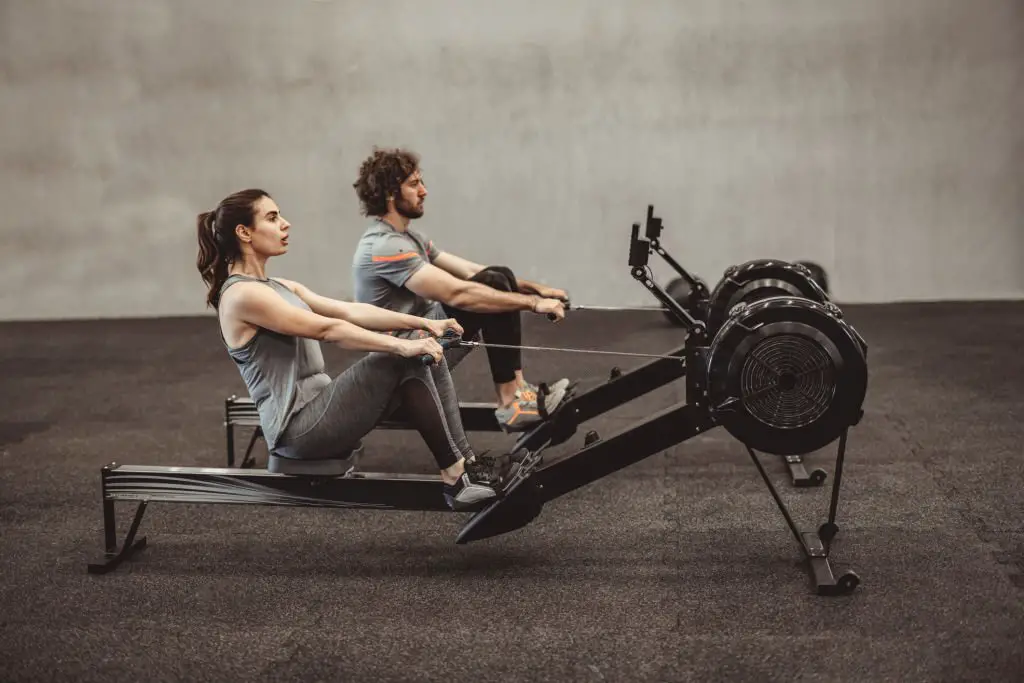If you’re looking to lose weight and want an effective workout that doesn’t put too much strain on your joints, look no further than the rowing machine. Rowing is a low-impact exercise that can help you burn calories quickly while building endurance and strength. In this blog post, we’ll explore how long you should be using the rowing machine for weight loss, as well as some of the best workouts and technique tips to make sure you get the most out of your time on the machine.
Table of Contents
Understanding Weight Loss and Rowing
Rowing is a great exercise for weight loss, as it can burn a high amount of calories in a short amount of time. To lose weight with rowing, it’s important to understand the number of calories burned on the machine and factors that affect calorie burn.
Rowing can burn a high amount of calories in a short amount of time, making it an effective exercise for weight loss.
The length of time spent on a rowing machine for weight loss depends on various factors such as body composition, intensity level, and workout frequency. Generally speaking, consistent workouts for at least 30 minutes per day can lead to successful weight loss over time. However, incorporating both steady-state sessions and interval training can help maximize results while keeping workouts engaging and challenging.
Calories Burned on a Rowing Machine
Rowing is an excellent full-body workout that can help you burn calories and lose weight. The number of calories you burn during rowing depends on various factors such as your weight, intensity level, and duration of the workout. However, on average, a person weighing 160 pounds can expect to burn about 500-600 calories in an hour-long session on a rowing machine.
Compared to other workouts like jogging or cycling at the same intensity level, rowing burns more calories per time spent exercising due to its engagement of multiple muscle groups simultaneously. To track your calorie expenditure while using a rowing machine, most machines have built-in calorie counters based on resistance levels chosen and stroke rate for accuracy. It’s essential to use good technique consistently when using the equipment so that you get maximum results from your efforts.
Factors that Affect Calorie Burn
During rowing exercises, various factors can affect the number of calories burned. Your resistance level and stroke rate play significant roles in the calorie burn process. The higher your resistance level and stroke rate, the more calories you’ll burn as a result of your increased exertion during exercise.
Another factor that determines calorie burn is body weight. Generally speaking, individuals with more weight will burn more calories than those with less weight during their workouts because they require more energy to move their bodies back and forth on the rowing machine.
Age and sex are also essential considerations when it comes to calorie burning. Age impacts metabolism levels while sex affects muscle mass percentages differently between males and females, both affecting how many overall calories you’ll be able to lose while working out on a rowing machine over time.
How Much Time on a Rowing Machine for Weight Loss?
Understanding the relationship between time spent, intensity, and weight loss goals is key to maximizing your workout on a rowing machine. For beginners with a focus on weight loss, starting with 20-30 minute sessions at moderate intensity can be effective. Incorporating interval training can also increase caloric expenditure in shorter amounts of time.
For advanced techniques to maximize caloric expenditure in shorter amounts of time, consider incorporating high-intensity interval training (HIIT) or Tabata-style workouts. These involve short bursts of intense effort followed by brief periods of rest for recovery. It’s important to listen to your body and gradually increase the duration and intensity of these workouts over time. Remember that consistency is key when it comes to achieving weight loss goals on a rowing machine – aim for regular workouts several times per week for the best results.
Best Rowing Workouts for Weight Loss
Rowing is a full-body workout that can help with weight loss. Interval training on the rowing machine is an effective way to burn fat and increase metabolism. Short bursts of high-intensity rowing followed by active recovery periods are perfect for those who want to lose weight quickly.
Endurance training on the rowing machine is another great option for weight loss. Long, steady-state workouts at a consistent pace can improve cardiovascular health and endurance while burning calories. Mixing in intervals or increasing resistance can also challenge your body and promote further fat loss.
Remember to focus on proper technique when using the rowing machine, especially if you’re new to it. A strong core, engaged legs, and relaxed grip will help you get the most out of your workouts while preventing injury.
Interval Training on the Rowing Machine
Interval Training on the Rowing Machine is an excellent way to burn calories and increase your stamina. Here are three types of interval training you can try:
- Tabata workouts:
- This high-intensity workout involves alternating 20 seconds of all-out effort with 10 seconds of rest. Repeat this cycle for four minutes or eight rounds.
- Pyramid intervals:
- Start with a short burst of intense rowing, then gradually increase the duration before decreasing it again. For example, start with one minute at maximum intensity, then two minutes at moderate intensity, three minutes at low intensity and so on until you end up back at one minute.
- HIIT (High-Intensity Interval Training):
- Similar to Tabata workouts but slightly longer intervals (think 30 seconds work followed by 15 seconds rest) repeated for several rounds.
Try incorporating these interval workouts into your routine to achieve maximum results in less time on the rowing machine!
Endurance Training on the Rowing Machine
Long, steady-state rows at a moderate pace for fat burning. This type of training involves maintaining a consistent speed over an extended period. It is ideal for beginners who want to build their endurance while losing weight. By keeping your heart rate in the target zone, you’ll burn more calories and improve cardiovascular fitness.
Continuous rowing at a challenging but sustainable pace to build endurance. To improve your stamina and push beyond your limits, try continuous rowing workouts that focus on achieving longer distances or durations gradually. This approach challenges both the physical and mental aspects of your training while building muscle strength and lung capacity.
Power strokes with active rest periods in between sets can be useful for advanced athletes looking to take their performance up a notch by alternating high-intensity intervals with lower-intensity recovery periods. These power-based workouts require bursts of energy during each stroke followed by brief moments of rest before starting again – this process helps increase overall metabolic demand leading to increased calorie expenditure long after you have finished exercising!
Strength Training on the Rowing Machine
Damper setting variation is one way to target different muscle groups while strength training on the rowing machine. By adjusting the damper settings, you can increase or decrease resistance and work on specific muscle groups like quadriceps, hamstrings, or glutes.
Another effective method of strengthening workouts with the rowing machine is by using resistance bands for added resistance work. Resistance band-assisted training adds an extra challenge to your workout routine and helps strengthen your muscles at a faster rate. Additionally, strokes rates adjustments can improve power and strength in various parts of your body as well. Here are some other ways to get started on building strength through rowing:
- Incorporate interval training into your routine
- Use proper technique during each stroke
- Focus on form over speed
- Increase intensity gradually over time
- Combine with other cross-training activities
By incorporating these techniques into your regular exercise regime, you’ll be able to achieve significant improvements in muscular endurance and overall fitness level.
Technique Tips for Effective Rowing Workouts
To get the most out of your rowing workouts, it’s essential to focus on proper posture and alignment. Sit tall with your shoulders back and feet firmly planted, ensuring that you maintain a straight spine throughout your stroke. This not only helps prevent injury but also maximizes the power generated by each stroke.
In addition to perfecting form and technique, incorporating breathing techniques can help take your rowing workouts to the next level. Try exhaling forcefully at the end of each stroke to engage core muscles while simultaneously providing an extra boost of energy for subsequent strokes. With these technique tips in mind, you’ll be well on your way to achieving an effective and efficient rowing workout routine.
Proper Posture and Alignment
Maintaining proper posture and alignment is crucial to get the most out of your rowing machine workout. Keeping a neutral spine can help prevent back injuries and ensure that you’re engaging the right muscles. Aligning your shoulders with the handle can improve your stroke efficiency and reduce strain on your arms and upper body.
Additionally, it’s important to keep your feet strapped in tightly to maintain stability during each stroke. By focusing on these key elements of posture and alignment, you’ll be able to row more effectively for longer periods of time without experiencing pain or discomfort.
Efficient Stroke Technique
Initiating movement from the legs first, then hips and arms can significantly improve your rowing technique. This sequential approach helps in generating maximum power with every stroke while also minimizing the risk of injury to your lower back. Remember to keep your core engaged, straighten your legs before leaning back, and finally pulling the handle towards you.
Maintaining a smooth and consistent rhythm throughout each workout is crucial for building endurance and stamina. Avoid sudden jerky movements or stopping mid-stroke as it can disrupt this flow. Instead, focus on finding a pace that works for you and stick with it until the end.
When working on improving efficiency in your stroke technique, remember that powerful drives are more important than rapid strokes. Make sure you’re using enough resistance settings to stimulate muscle growth while still being able to maintain proper form during each repetition. With patience and dedication over time, these habits will become ingrained into muscle memory- leading to better performance and increased calorie burn!
Breathing Techniques

Incorporating proper breathing techniques while using a rowing machine can significantly improve your performance and power output. Here are some essential tips to keep in mind:
- Exhale on exertion principle:
- To maximize your power output, exhale during the stroke’s most challenging part. This technique helps you engage your core muscles and generate more force.
- Inhale on recovery:
- During the recovery phase, inhaling helps maintain a steady breathing pattern and prepare for another powerful stroke.
- Nose Breathing vs. Mouth Breathing:
- While both methods have advantages, nose breathing is generally more effective as it warms up the air before it enters the lungs, making it easier to breathe.
By implementing these simple yet effective breathing techniques into your rowing workout routine, you can make significant progress towards achieving your fitness goals.


